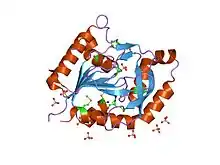Glutamine amidotransferase
In molecular biology, glutamine amidotransferases (GATase) are enzymes which catalyse the removal of the ammonia group from a glutamine molecule and its subsequent transfer to a specific substrate, thus creating a new carbon-nitrogen group on the substrate. This activity is found in a range of biosynthetic enzymes, including glutamine amidotransferase, anthranilate synthase component II, p-aminobenzoate, and glutamine-dependent carbamoyl-transferase (CPSase). Glutamine amidotransferase (GATase) domains can occur either as single polypeptides, as in glutamine amidotransferases, or as domains in a much larger multifunctional synthase protein, such as CPSase. On the basis of sequence similarities two classes of GATase domains have been identified: class-I (also known as trpG-type) and class-II (also known as purF-type).[1][2] Class-I GATase domains are defined by a conserved catalytic triad consisting of cysteine, histidine and glutamate. Class-I GATase domains have been found in the following enzymes: the second component of anthranilate synthase and 4-amino-4-deoxychorismate (ADC) synthase; CTP synthase; GMP synthase; glutamine-dependent carbamoyl-phosphate synthase; phosphoribosylformylglycinamidine synthase II; and the histidine amidotransferase hisH.
| Glutamine amidotransferase class-I | |||||||||
|---|---|---|---|---|---|---|---|---|---|
 crystal structure of putative glutamine amido transferase (tm1158) from thermotoga maritima at 1.70 a resolution | |||||||||
| Identifiers | |||||||||
| Symbol | GATase | ||||||||
| Pfam | PF00117 | ||||||||
| Pfam clan | CL0014 | ||||||||
| InterPro | IPR000991 | ||||||||
| PROSITE | PDOC00406 | ||||||||
| MEROPS | C44 | ||||||||
| SCOP2 | 1ea0 / SCOPe / SUPFAM | ||||||||
| CDD | cd01653 | ||||||||
| |||||||||
References
- Weng ML, Zalkin H (July 1987). "Structural role for a conserved region in the CTP synthetase glutamine amide transfer domain". Journal of Bacteriology. 169 (7): 3023–8. doi:10.1128/jb.169.7.3023-3028.1987. PMC 212343. PMID 3298209.
- Nyunoya H, Lusty CJ (August 1984). "Sequence of the small subunit of yeast carbamyl phosphate synthetase and identification of its catalytic domain". The Journal of Biological Chemistry. 259 (15): 9790–8. PMID 6086650.